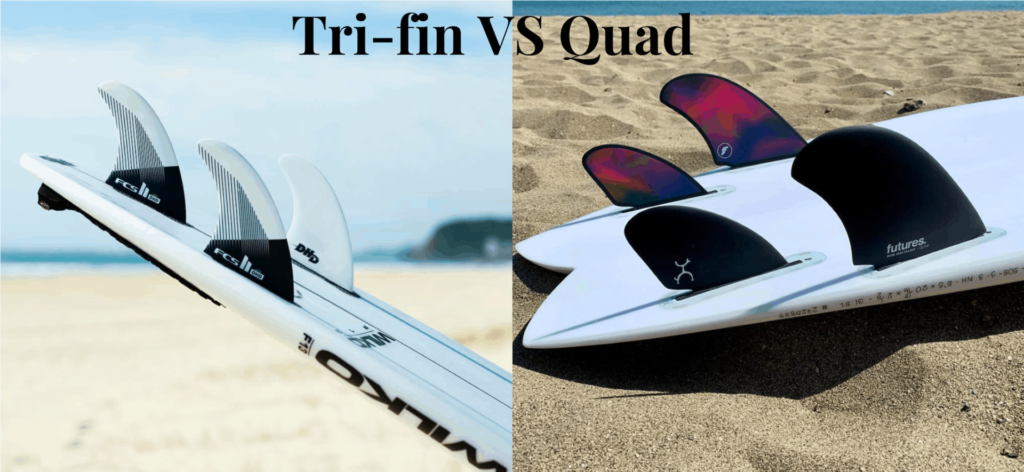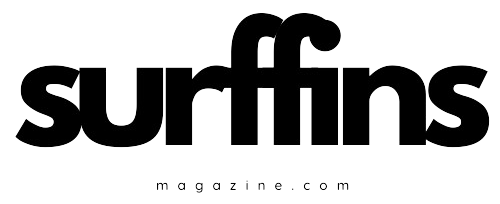
Surf fins Tri fin or Quad?
In our article how many fins to use , we talked about the different fin configuration options that exist in the world of surfboards. Single Fin , Twin Fin, thruster or trifin, quad, five fins or even six fins. Today we want to talk to you about the difference between tri fin and quad and when you should use one system or the other depending on the type of wave you are going to surf.
What is better Thruster or Quad?
With an increasing number of surfboards with the option of configuring 3 fins or Quad, the question we are often asked is: ‘What is better … Tri fin or quad?’. At SFMagazine we could recommend boards with the possibility of both configurations and even the most suitable fin model for each board. But the question remains the same. How should I surf this board?
Unfortunately, there is no simple answer to this question. In short, both are great. But it all depends on what you want to get out of each configuration. Fins play a significant role in the performance of your board. According to our experience, fins represent almost 40% of the performance of your board. Changing your fins or their configuration, can give you a completely different feeling on the same board. To understand the usefulness of the fins, it is important to briefly explain their history and evolution. The Single Fin, emerged to help give large and heavy boards some traction and stability. It was refined over time to help produce retention. The Twin Fins on the other hand, came into play to provide maneuverability and additional drive.
Tri fin, thruster or 3 fins
Tri fin, trifin, thruster…this 3-fin system was invented by the surfer and shaper Simon Anderson in 1980. Undoubtedly it is the most used fin configuration. Simon Anderson created this 3-fin system under the name of Thruster. Anderson would demonstrate the efficiency of this system a year after its invention, winning the Bells, Surfabout, and Pipeline contests. The Australian shaper won no less than four titles with the novelty of the three fins.

Simon Anderson the inventor of the 3 fins
Simon Anderson developed the thruster (Tri-Fin) to give it an edge over the Twin Fin design. In addition to being a shaper and inventor of the thruster, is a great surfer with powerful footwork. Balance between speed and control.
Quad or 4 fins
The quad configuration was popularized by Kelly Slater . This 4-fin configuration offers This configuration of 4 fins offers a lot of grip and acceleration power . Faster and with good performance in tubes. They are the most used in the world circuit tests like Pipeline. A good choice for big waves, as due to the huge amount of water flowing between the fins, it achieves greater stabilization of the surfer. Kelly Slater uses them in both small and big waves.

Kelly Slater maximum ambassador of the system
The Quad Fin almost combines the attributes of the Twin Fin and the Tri-Fin . The quad configuration adds speed in the line without the resistance and drag of the central fin of the Tri-Fin, but with greater maneuverability and control than the Twin Fin.
If you are thinking of buying quad type fins we recommend the new Rob Machado Quad Seaside fins . Some lightweight fins, ideal not only for Firewire Seaside but for all types of quad boards.

Quillas ROb Machado Quad
So, what is the difference between thruster and quad?
The Quad fills that gap where the Thruster or Twin Fin fall short. Everyone wants that feeling of speed while maintaining control. This is precisely where the Quad comes into play. The quad setup can also be used on powerful and hollow waves or on small and weak waves. But always taking into account the aspect we mentioned before about the location of the rear fins relative to the front fins.
When to use Quad fins?
On smaller weak wave days, having a Quad with the rear fins closer to the rail and a little higher up really quickens the board. Allowing you to perform quick maneuvers, slide the tail easily, and generate much more speed through the wave faces, as there is no resistance from a center fin.
For larger hollow days, quads with the rear fins slightly back and close to the rail provide an extra speed and stay on the face of the wave. Being able to take higher lines on more vertical waves with the additional hold of having two fins on the rail. Additionally, you will gain extra speed because the central fin does not drag. This is very useful in barreling waves where there is not much room to turn. In addition, quads compared to a Thruster, are faster out of the barrel. As soon as you stand up, quads will provide you with instant speed down the line instead of having to pump and control the board.
When to use Thruster fins?
There is a good reason why the Thruster setup has been, and continues to be, the most common fin setup of the last 30 years. In short, they are predictable and work . But if quads are so functional, why is the Thruster still considered?
The Thruster is perfect for those super peaky days. Where the peaks are great, whether in small waves or on days with hollow waves that are on the lower line. The Thruster gives you what you want when you have space to surf, rather than draw lines. The Thruster gives you controlled surfing that is useful when you want to surf at a higher level with good quality waves. Think of those closing days with sizes that go top to bottom , but with plenty of room to move, do airs or turns in the critical part of the wave. This is where your Thruster will shine.

Thrusters still work on both small and big waves. But it all comes down to the combination of the fins with the board and what the surfer prefers. Nowadays, you see some big wave surfers riding quads. And precisely they do it for that extra speed and ability to hold a high line. However, other surfers prefer the stability and additional control provided by the Thruster.
Recommended reading: Feather Fins, the Galician surf fin brand

What now?
If you are curious on how to find the best board, truster or quad fin, our friends at Boards Magazine have many reviews on them, letting you know your surfing level and what you need at each. Also, we have an article on wich types of fins are the best for your level. But, all in all, why not have the chance to change your fin setup to fit the conditions?
After all, surfing, like other sports, is about experimenting. Do not be afraid to buy a board with more fin boxes than you usually use. That is, if you usually surf on a thruster and you buy a board with a combo setup (5 fins), do not worry about not using all the boxes. Having a board with 5 fins and using it as a thruster or quad will not make a significant difference in terms of drag.
From SFMagazine, we encourage you to try different things.
OUTLET FINS
Yes, it is true that some Shapers have designed certain models to work with Tri-Fin or with a quad configuration. But not with both. This is rare. But it happens. Still, if they allow you the option to go with five fins, do it. Look at the Hypto Krypto. Hayden Cox designed this board originally to work specifically as Tri-Fin.
The shape and the bottom contours of the board are supposed to give it enough speed so that it is not necessary to go quad. But, due to popular demand, he ended up launching the Hypto Krypto with 5 fins Precisely so that surfers could experiment. It was not as simple as putting a couple of additional boxes on the board. Hayden really had to think about how to place the fins in both designs.

Hypto Krypo 5 fins
In summary, if you have the option to set up your board with five fins, do it You are not losing anything. Just gaining. And you will never know until you try.
We hope you all liked this trifin vs quad comparison. If you have any questions, please let us know them. Dont forget to subscribe to our newsletter not to miss any of our articles from this sport we all love.
